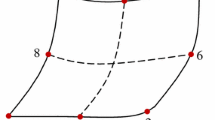Abstract
In boundary element methods the treatment of singular integrals, as one of the main numerical problems has been noticed seriously. In this paper, by using polar coordinate transformation for elements a new approach is proposed to remove the singularities in the integrals explicitly. The formulations for treatment of the singularities in quadrilateral boundary elements with four nodes, eight nodes and nine nodes are derived and it can be extended easily to other higher order boundary elements. Numerical examples are given. The results show the present approach is effective and efficient.
Similar content being viewed by others
References
Cruse, T.A., An improved boundary-integral equation method for three-dimensional elastic stress analysis,Computer and Structures,4 (1974), 741–754.
Jeng, G. and A. Wexler, Isoparametric, finite element, variational solution of integral equations for three-dimensional fields,Int. J.Num. Meth. Eng.,11 (1977) 1455–1471.
Webster, W.C., The flow about arbitrary, three-dimensional smooth bodies,J. of Ship Research,19, 4 (1975), 206–218.
Oken, E.E., The potential integral for a linear distribution over a triangular domain,Int. J. Num. Meth. Eng.,18 (1982), 1821–1828.
Lachat, J.C. and J.O. Waston, Effective numerical treatment of boundary integral equations: a formulation for three dimensional elastostatics,Int. J. Num. Meth. Eng.,10 (1976), 999–1005.
Zang Yue-long and Ji Xing, The calculation precision of three-dimensional Boundary Element Methods for elastostatics,Proc. of 1st Conf. of Boundary Element Methods in Engineering, China (1985), 149–155. (in Chinese)
Telles, J.C.F., L.C. Wrobed and C.A. Brebbia,Boundary Element Technology Theory and Application in Engineering, Springer-Verlag (1984), 448–454.
Brebbia, C.A. and S. Walker,Boundary Element Techniques in Engineering, Butterworth Ltd., (1980).
Bath, K.J. and E.L. Wilson,Numerical Methods in Finite Element Analysis, Prentice-Hall, Inc. (1976), 120–123.
Smith, A.M.O. and J. Hess, Calculation of non-lifting potential flow about three-dimensional bodies, Douglas Aircraft Company, Report E.S. 40622 (1962).
Kaleff, P., A hydroelastic approach to ship vibration problems,J. of Ship Research,27, 2 (1983), 103–112.
Author information
Authors and Affiliations
Additional information
Communicated by He You-sheng
Rights and permissions
About this article
Cite this article
Yong-hui, L., Xin-sen, L. Polar coordinate transformation approach for treatment of singular integrals in boundary element methods. Appl Math Mech 9, 959–967 (1988). https://doi.org/10.1007/BF02014602
Received:
Published:
Issue Date:
DOI: https://doi.org/10.1007/BF02014602




